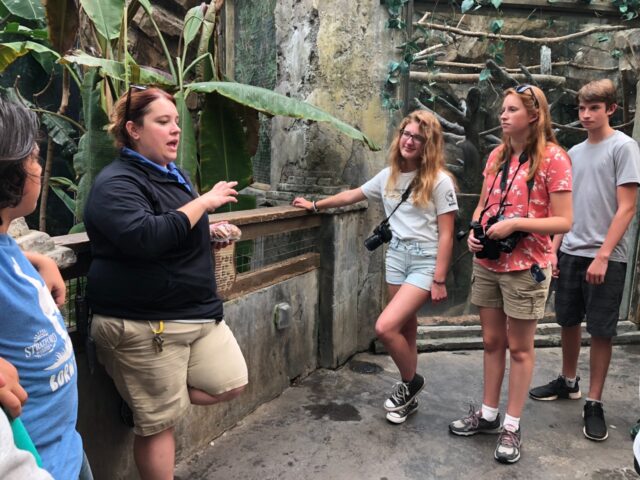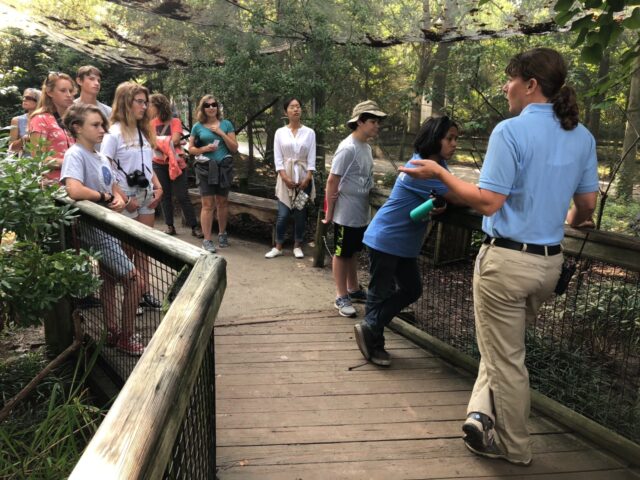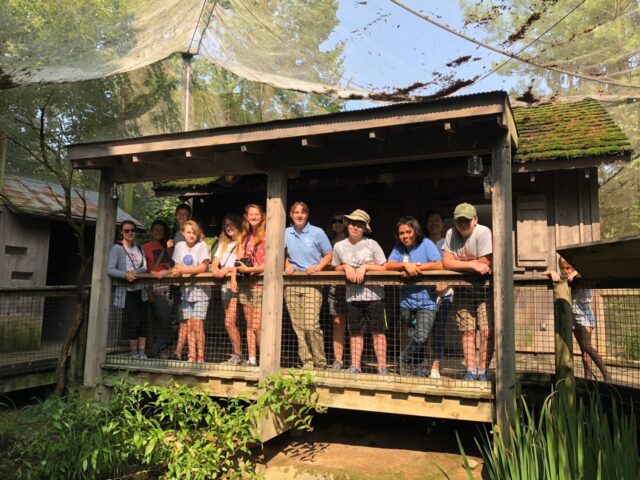Flamingos and Penguins at the Columbus Zoo and Aquarium
On August 19, 2018, the Central Ohio Chapter of the Ohio Young Birders Club went on a birding trip to the Columbus Zoo and Aquarium. One of our stops was the flamingo exhibit, where we got to go behind the scenes and pet baby flamingos. We learned that flamingos typically live 30-40 years. However, the oldest one ever recorded is 82. They usually grow to 3.3 – 4.6 feet tall and weigh 3.3 – 9 pounds. At the zoo flamingos are fed two different types of pellets giving them all their nutrition. In the wild flamingos would eat shrimp, algae, and crustaceans which gives them their pink colored feathers.
For our next stop we went to the Humboldt Penguin exhibit. We learned that these penguins are warm weather penguins from South America. In captivity their average life span is 20 years, however few would reach this age in the wild. They like their water temperature at 55-60 degrees. Each pair mate for life and have matching colored wing bands. Sadly, the Humboldt Penguin is endangered with their numbers in a steady decline in recent years. There are only 2,500-12,000 left in the world today.
Zak Beaver (age 14)
OYBC Behind the Scenes Tour of the Columbus Zoo – Australia
At the Behind the Scenes tour of the Columbus Zoo, one of the areas we visited was Australia. There were lots of Australian birds for us to see. Both of the bird species we saw live the forests of Australia. The bird exhibits we saw have 12 hours of light, and 12 hours of dark.
The first bird was the Kookaburra. It is the largest member of the Kingfisher family, and it kills prey by smacking it on a log. It does this to lizards and snakes. They are separated from the other birds, because they are aggressive and might kill them. The Kookaburra we saw wasn’t super active, but we did get to hear it call. There were three or four of the Kookaburra in the exhibit, and one of them was missing an eye.
Next we went to the Rainbow Lorikeet exhibit. One interesting fact about the Rainbow Lorikeet is that they don’t have a good sense of smell. They mostly eat apples and bananas. They are hand fed their food 21 days every month. They are very noisy birds! Some of the lone Lorikeets are sent from other zoos, to join the flock at our zoo.
Matthew Rice (age 12)
The North American Aviary at the Columbus Zoo
On August 19th, the Central Chapter of the Ohio Young Birders Club went on a field trip to the Columbus Zoo. We went on a behind-the-scenes tour of several of the aviaries to learn more about how the birds are cared for.
I really liked the North American aviary, which had Indigo Bunting, Rose-breasted Grosbeak, Scarlet and Summer Tanagers, and Orioles as well as other species. I learned that most of the individual birds in the aviary have some sort of injury and could not be released into the wild on their own.
The species in the aviary are migratory birds that would not normally be found in Ohio in the winter, so I was surprised to learn that most of the birds remain outdoors year-round. They don’t have a problem with the cold, so long as they have a good food supply and evergreen shrubs where they can shelter. But they do have the option to go inside if they want to.
Thanks to the staff of the Columbus Zoo and to our group leaders for organizing a great trip.
Raul Castro-Dean (age 12)





